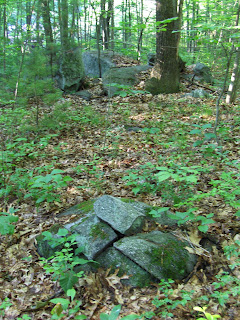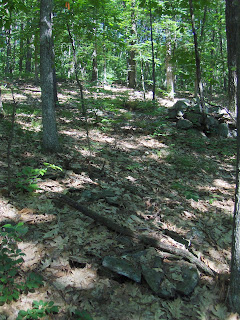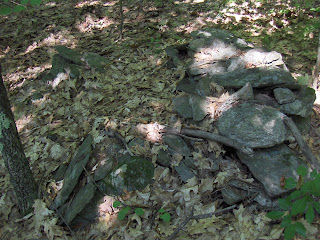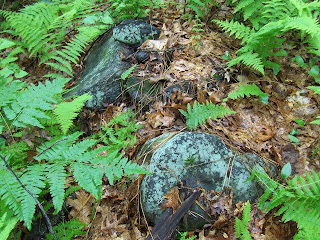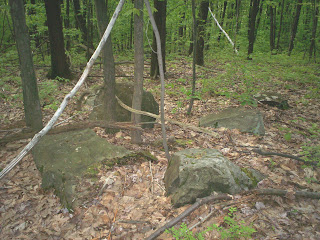On my way to our summer home in NH, I stopped by S*, NH, to see a lithic site that a resident of the town mentioned to me. He has sent me a few images of some of the features beforehand, so I had some inkling what to expect. Still, when I got to see the site, which is on the east side of a large lake, I was blown away, because it soon dawned on me that this is a major New England site, whose size has not yet been determined. I saw only a small portion of it, but it seems to go on and on.
There are cairns and small stone piles of all sorts, from large, very well made platform cairns of the rectangular, square, triangular and irregular variety, but constructed with huge stones, to single boulders placed on top of oher ones. Many of the features I saw are near roads and houses, most having been built in the last fifty years. Some of the boulders comprising them must weigh a ton or more. When I wandering through the woods, stone constructions were everywhere I looked. I was most impressed by the amount of work that undoubtedly went into constructing the cairns, and manipulating large boulders to be placed on top of smaller ones, since a team of men must have been required. None of the features was on what I would call agricultural land: it was all rocky and hardly suitable for growing anything.
One feature that initially took me by surprise was a large boulder placed on some smaller ones. My guide pointed out what appeared to be a long exposed drill hole, 21cm long and 2.7cm in diameter, along the bottom part of a boulder. The entry hole is at the bottom. Once I saw this, I thought of all kinds of problems -- that I had been taken in and that all of this area was the doings of a crazy farmer -- but then I noticed that the drill shaft was slightly bent and not straight. What could have made this? It does seem like a drill hole, since the inside surface is mostly smooth, but with some irregularities that may be seen in the photo. And the boulder does seem to have broken apart along the face, but the surface is covered with lichen and it looks old.
I am attaching a selection of pictures I took yesterday.
Image 10 is of a large platform cairn with a niche in one corner, and in the niche was a small quartz stone.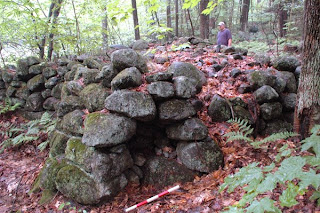

Image 27 shows a large boulder placed on top of another boulder or rounded ledge outcrop, with smaller stones placed around the edges. 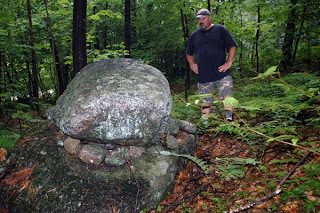 There were at least a half dozen examples I saw like this such as the next image (31).
There were at least a half dozen examples I saw like this such as the next image (31).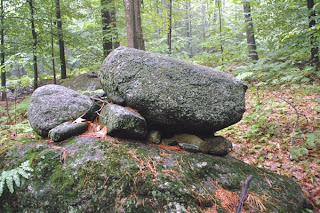
 There were at least a half dozen examples I saw like this such as the next image (31).
There were at least a half dozen examples I saw like this such as the next image (31).
Image 47 is of a huge glacial erratic with small stones carefully piled on top. A half metric scale can be seen on the ground to the right of the erratic.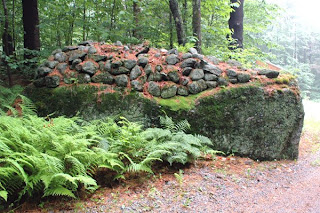

Image 57 shows some of the variety at this site, in this instance one or two large boulders piled on top of existing ones.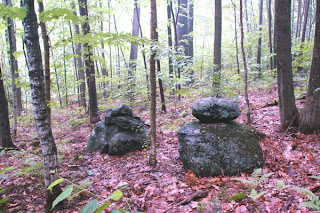
Update:
Norman also writes:
That boulder with the drill hole initially bothered me, because I thought it was probably evidence of Colonial involvement. Yet the way the boulder was perched on smaller stones (see attached images) contradicted this interpretation, since there were other boulders in the area arranged in this manner, too. I don't think a metal drill was used, since the hole should be straighter and not bent, and thus the hole was probably made with one with a flexible shaft, meaning something like a reed worked with an abrasive like sand.
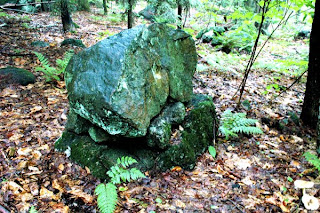

Update:
Norman also writes:
That boulder with the drill hole initially bothered me, because I thought it was probably evidence of Colonial involvement. Yet the way the boulder was perched on smaller stones (see attached images) contradicted this interpretation, since there were other boulders in the area arranged in this manner, too. I don't think a metal drill was used, since the hole should be straighter and not bent, and thus the hole was probably made with one with a flexible shaft, meaning something like a reed worked with an abrasive like sand.











